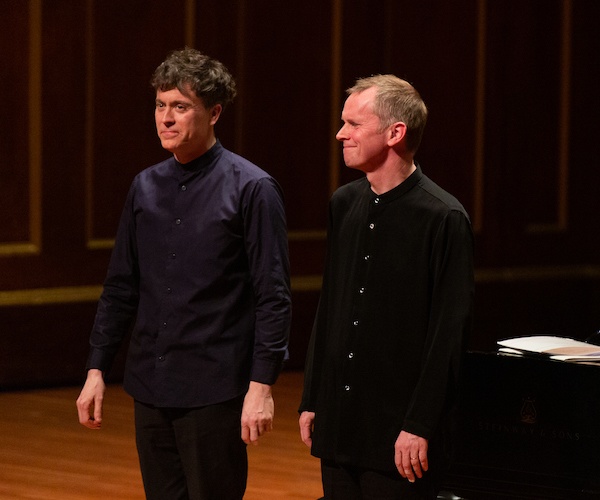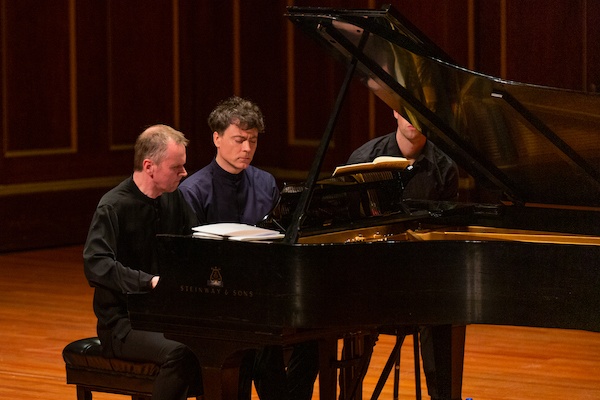Concert Review: Steven Osborne and Paul Lewis — A Very French Duo Piano Recital
By Susan Miron
It was as if the pianists were performing in a small drawing room for a few friends, not at Jordan Hall.

Paul Lewis (l) and Steven Osborne performed a duo-piano recital presented by the Celebrity Series of Boston at NEC’s Jordan Hall on Friday night. Photo: Christani Pal.
British pianist Paul Lewis made an indelible impression on me during his first Celebrity Series appearance in 2013, an all-Schubert program. I have been an admirer of his ever since, enjoying his many recordings, particularly the recently released complete Beethoven Sonatas and Piano Concertos (Harmonia Mundi). Friday evening was his fourth appearance, and he brought along his esteemed friend, Scottish pianist Steven Osborne, for an evening of four-hand (one piano) duets. Lewis is renowned for his performances and recordings of the music of Schubert, Beethoven, and Haydn. This summer he will be playing all five Beethoven concerti with the Boston Symphony Orchestra at Tanglewood. This was Steven Osborne’s debut on the Celebrity Series, and the first time this esteemed organization had ever sponsored a four-hand piano program.
“Steven and I,” Lewis wrote of the friends’ rapport, “began playing duets about 20 years ago. It’s always a pleasure to make music with him. This is beautiful music that, on the whole, was written for friends to play together.” Indeed, it was a pleasure hearing them blend seamlessly as a duo, each taking turns at the bottom and top of the keyboard, ending each piece with an identical flourish or arms flung into the air.
This was an important Celebrity Series first, so the pianists’ choice of a very French program seemed odd, especially given that Gallic music is hardly, if ever, featured on Lewis’s programs or CDs and Osborne has such a wide-ranging repertoire. Both have chops galore — why choose so many pieces composed for children or amateurs? Most of the compositions, written between 1896 and 1918, partake of a similar sound world. (The duo’s CD on Hyperion features music of Schubert).
Maurice Ravel, whose Mother Goose Suite ended the program, loved miniatures, and this recital was chockablock with short suites made up of brusque movements. The proceedings began quietly and delicately — and stayed this way for much of the evening. It was as if the pianists were performing in a small drawing room for a few friends, not at Jordan Hall. The decibel level did not rise above mf (mezzo forte) during the written part of the program. Several of the pieces, penned for young children, were remarkable exercises in simplicity, whimsy, and dreaminess. It was like entering a lovely, protected trance, floating, with a few interruptions, in sweetness, whimsy, and Gallic charm.
The evening opened with Gabriel Fauré’s (1845-1924) “Dolly, Six Pieces for Piano Duet,” opus 56. Nearly a century after his death, Fauré is, I believe, underrated, known best for his extremely popular Requiem, songs, and chamber music. Yet he taught Maurice Ravel, who dedicated his quartet to him, and composer Arthur Honegger considered him among France’s finest composers. The renowned French teacher of many talented American pianists, Nadia Boulanger, taught Fauré’s principles for the 50 years after the end of World War I. Aaron Copland pithily said this of Fauré’s compositions: “To the superficial listener he probably sounded superficial. But those aware of musical refinement cannot help admire the transparent texture, clarity of thought and well-shaped proportions. Together they constitute a kind of magic that is difficult to analyze but lovely to hear.”
Fauré wrote these six pieces between 1894 and 1896, while he was romantically attached to Emma Bardak. Dolly was the nickname for Emma’s five-year-old daughter, Heléne Bardak, who received these elegant short pieces as a birthday gift. (Similarly, Debussy wrote his Children’s Corner about 10 years later to celebrate his second wife’s birth of their child).
The next piece was by Francis Poulenc (1899-1963), “Sonata for Piano Four-Hands,” written in 1918 and revised in 1939. Only five minutes long, the composer thought of it as one of his “essays in free melody,” reacting to what he derisively called “Impressionist Snow.” The energetic sonata’s rambunctious Prélude, sentimental Rustique, and ebullient Final movement reflect the unmistakable influence of Stravinsky and Erik Satie.
(I enjoyed these 2019 program notes from Music @ Menlo:
Poulenc strove to integrate Western classical music with popular styles including jazz, vaudeville, cabaret, and even circus music. His music reflects this ideal in its devilish stylishness. The Opus 8 Sonata for Four-Hand Piano is a youthful work, both chronologically (composed in 1918, when Poulenc was not yet twenty, and then revised in 1939) and in its zestful flair. (Poulenc would later return to music for two pianists, composing the Opus 156 Sonata in 1952–53 and Opus 175 Elégie in 1959, each requiring two pianos, and the Opus 61 Concerto for Two Pianos and Orchestra in 1932—thus extending a tradition that so captivated Mozart and Schubert before him.) The Sonata’s three short movements—labeled Prelude, Rustique, and Final—bring together invigorating ostinato figures, exotic harmonies, and popular-sounding tunes. Poulenc’s own assessment of the musical character he shared with his compatriots is especially apt for this particular work: “You will find sobriety and dolor in French music just as in German and Russian. But the French have a keener sense of proportion. We realize that somberness and good humor are not mutually exclusive. Our composers, too, write profound music, but when they do, it is leavened with that lightness of spirit without which life would be unendurable.”
Claude Debussy’s (1863-1916) enchanting Six Épigraphes Antiques began life as incidental music for a single performance of Debussy’s friend Pierre Louÿs’s Chansons de Bilitis. The score was unpublished; rather than toss aside good material, in 1914 Debussy set about half of it for piano, four hands. I have always found its opening piece, “Pour invoker Pan, diet du vent d’éte,” to be irresistibly fetching, and am always happy to hear it again.

Paul Lewis (r) and Steven Osborn performed a duo-piano recital presented by the Celebrity Series of Boston at NEC’s Jordan Hall on Friday night. Photo: Christani Pal.
The second half of the pianists’ program began with Debussy’s popular 1889 Petite Suite (“En bateau, Cortège, Menuet, Ballet”), better known through Henri Büsser’s colorful 1907 orchestrated version. It was Debussy’s only work written for piano four hands, and the duo played it, like everything on the program, quite beautifully.
Trois pièces faciles (“Three easy pieces”) for Piano Duet by Igor Stravinsky (1882-1971) were written in Switzerland in 1914-15. They resemble other pieces that he wrote for his children as teaching tools. He characterized them as “popcorn,” although he liked them enough to arrange them for a variety of ensembles. In 1920, France became the adoptive home of the 38-year-old Stravinsky, whose Rite of Spring had set Paris on fire seven years earlier. Entertaining, endearing miniatures, they consist of a March, dedicated to Stravinsky’s friend, the composer Alfredo Casella; a Waltz, to composer Erik Satie; and a Polka dedicated to Sergei Diaghilev.
Maurice Ravel’s (1875-1937) magical Mother Goose Suite (Five Pieces for Children; 1910) is a great favorite of mine, in any form, particularly Ravel’s orchestration of these French fairy tales. (Years ago, my harp, flute, and viola trio transcribed it with the pentatonic third movement, “Ladroniette,” played by a piccolo and with an assist of a Chinese gong, which appears in Ravel’s orchestrated score.) Two children, ages six and seven (the kids Ravel chose to play it found the piece too difficult) premiered the composition. Ravel recalled, “My intention of awakening the poetry of childhood led me to simplify my style and thin out my writing,” This, and the duo’s encore, were the highlights of the evening, at least for this listener.
The duo’s seductive encore, the Dumka from Slavonic Dance # 72 in E minor by Dvorák, came the closest to the Central European repertoire for which Lewis is known. Passion, excitement, and a full-bodied sound provided a glimpse of the glories this recital might have provided if there had been a more varied selection of pieces. Maybe next time. And definitely Ravel’s La Valse, as long as I am fantasizing about what I’d love to hear this excellent duo perform.
Susan Miron, a harpist, has been a book reviewer for over 30 years for a large variety of literary publications and newspapers. Her fields of expertise were East and Central European, Irish, and Israeli literature. Susan covers classical music for The Arts Fuse and The Boston Musical Intelligencer.

